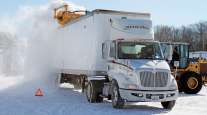Massive Blizzard Paralyzes Truckers, Leads to ‘Staggering’ Losses for Carriers
This story appears in the Feb. 7 print edition of Transport Topics.
At Beaver Express Service in Woodward, Okla., near the state’s panhandle, company president Mike Stone spent most of last week trying to figure out which of his terminals, scattered across six states, could reopen after a record-breaking blizzard buried them.
The massive storm, which started in New Mexico and Texas on Jan. 31, paralyzed Oklahoma and shut down Interstate 70 in Missouri on Feb. 1 before crossing the Great Lakes states into the Northeast.
By midweek Feb. 2, the sun was out over Stone’s Beaver Express office and the 50-mph winds had died down, but temperatures were still south of zero and the snow that idled his 300 trucks made many roads impassable.
“Yesterday, shutting down the entire company, that’s the first time that’s happened that I can remember in . . . forever,” Stone said last Wednesday.
He is the third generation of his family to run the LTL carrier. “It was so bad everywhere that we just couldn’t operate.”
Interstate 70, the major freight artery between Kansas City and St. Louis, did not reopen until 6:30 a.m. Feb. 2.
Illinois Gov. Patrick Quinn dispatched the National Guard to transport state troopers in Humvees to reach motorists and truckers on the Illinois Tollway.
In northern Ohio, where 14 inches of snow and ice covered the roads Feb. 1 and 2, officials restricted highways to emergency use and large employers closed.
At one point, parcel carrier UPS Inc. listed on its website 14 states where it could not make pickups and deliveries. By Feb. 3, UPS still was having problems in 45 ZIP codes in Michigan and Ohio.
“We may be able to go out for some deliveries, but the businesses are still closed,” said UPS spokeswoman Susan Rosenberg.
The Ohio Turnpike stayed open during the storm, as did the Indiana Turnpike, although high winds forced the latter to ban long combination vehicles for 24 hours.
At Beaver Express, Stone said late last week that he had yet to calculate his losses.
“So far, we haven’t had any accidents, no crashes or anything like that, no equipment was torn up, so that’s good,” Stone said. “But I don’t have a clue financially. It’s going to hurt; I can tell you that.”
In the Northeast, truckers were weary of the record-breaking storms that began before Christmas and show no signs of letting up.
“By far, this has been the worst winter across our system,” said Thomas Connery, chief operating officer of New England Motor Freight, headquartered in Elizabeth, N.J.
Despite the storms, NEMF, a large regional carrier, stayed current with its freight, in part by putting drivers on the roads ahead of each storm, Connery said.
He had not totaled up the storm costs, but they will be “staggering,” he said: “Labor to plow and remove snow, the cost of salt. We’ve used 360 tons so far this season. The lost revenue with customers closed because of the snow.”
Add in the maintenance, the wear and tear on equipment and the terminal yards torn up by repeated plowing, and “costs are out of sight,” Connery said.
In addition, New Jersey has a new snow removal law, under which truck owners can be ticketed if snow and ice accumulate on cabs and trailers. NEMF purchased 10 snow-removal devices costing more than $25,000 each, Connery said.
At Boyle Transportation in Billerica, Mass., a light rain fell Feb. 2 after yet another record-breaking snowfall. Andrew Boyle, executive vice president and chief financial officer, scrambled onto the roof to shovel, lest the rain make the snow even more dangerous.
The flat roofs typical of industrial buildings and truck terminals proved susceptible to cave-ins this year, Boyle said.
“All you need to know about this year’s winter in New England is that the Boston Globe newspaper is tracking cumulative snowfall relative to the height of Shaquille O’Neal of the Celtics. As of Feb. 2, we were up to Shaq’s shoulders,” Boyle said.
By now, truckers in his area are so numb from the repeated storms that the only thing to do is soldier on, Boyle said.
“Clearly, the loss of productivity is substantial,” he said. “Not only do you incur expenses for nonrevenue activities such as snow removal, but when customer facilities close, you also have freight queue up in your network.”
Boyle, a family-owned truckload carrier, runs in all 50 states.
“The economics of winter are unkind to carriers of any mode,” he said.
Record-setting snowfalls are busting municipal and state budgets, still reeling from the recession.
The American Highway Users Alliance has released a study by IHS Global Insight that estimated the overall economic effects in 16 U.S. states in terms of snow closures, lost tax revenue and losses at restaurants, retailers and service stations.
The study found that in Massachusetts, for example, paralyzing snowstorms cost the state’s economy $265 million a day. In New Jersey, the cost was $289 million a day; in New York, $700 million; and in Illinois, $400 million a day, according to the study.



